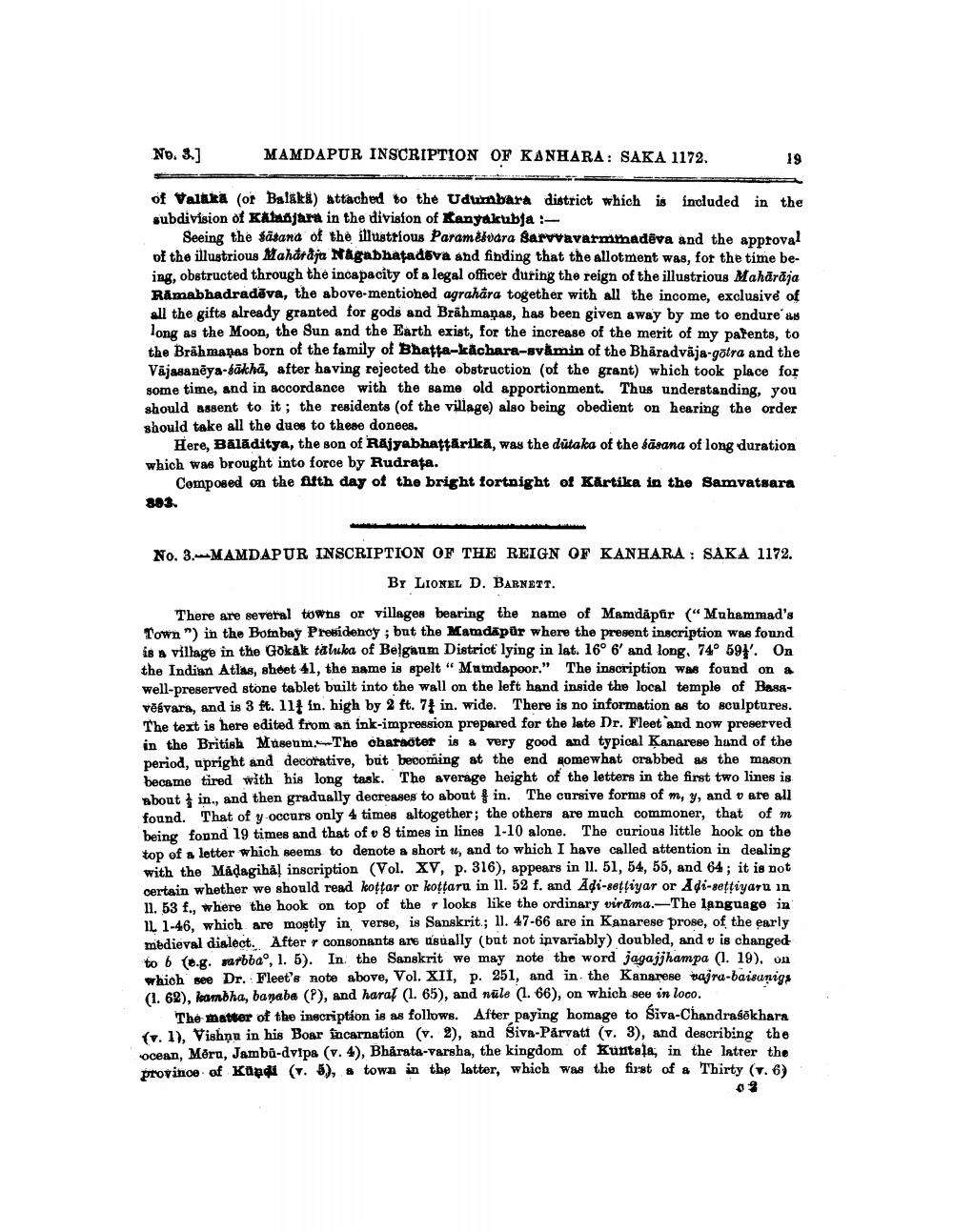________________
No. &]
MAMDAPUR INSCRIPTION OF KANHARA: SAKA 1172.
19
of Valuka (of Balaks) attached to the Udumbara district which is included in the subdivision of K anjar in the division of Kanyakubja :
Seeing the säsand of the illustrious Paramèsvara Sarvvavarmmadeva and the approval of the illustrious Maharaja Nagabhatadava and finding that the allotment was, for the time being obstructed through the incapacity of a legal officer during the reign of the illustrious Mahārāja Ramabhadradova, the above-mentioned agrahara together with all the income, exclusive of all the gifts already granted for gods and Brāhmaṇas, has been given away by me to endure as long as the Moon, the Sun and the Earth exist, for the increase of the merit of my patents, to the Brāhmaṇas born of the family of Bhatta-kāchara-svåmin of the Bhāradvāja-götra and the Vājaganēya-bākhå, after having rejected the obstruction (of the grant) which took place for some time, and in accordance with the same old apportionment. Thus understanding, you should assent to it; the residents (of the village) also being obedient on hearing the order should take all the dues to these donees.
Here, Bälāditya, the son of Rajyabhattārikā, was the dütaka of the sāsana of long duration which was brought into force by Rudrata.
Composed on the fifth day of the bright fortnight of Kartika in the Samvatsara 893.
No. 3.-MAMDAPUR INSCRIPTION OF THE REIGN OF KANHARA, SAKA 1172
BY LIONEL D. BARNETT. There are several towns or villages bearing the name of Mamdapfir (“Muhammad's Town") in the Bombay Presidency, but the Mamdāpur where the present inscription was found is a village in the Gokak taluka of Belgaum District lying in lat. 16° 6' and long, 74° 591. On the Indian Atlas, sheet 41, the name is spelt "Mumdapoor." The inscription was found on a well-preserved stone tablet built into the wall on the left hand inside the local temple of Basavēbvara, and is 3 ft. 114 in. high by 2 ft. 74 in. wide. There is no information as to sculptures. The text is here edited from an ink-impression prepared for the late Dr. Fleet and now preserved in the British Museum.-The character is a very good and typical Kanarese hund of the period, upright and decorative, but becoming at the end somewhat crabbed as the mason became tired with his long task. The average height of the letters in the first two lines is about in., and then gradually decreases to about in. The cursive forms of m, y, and v are all found. That of y-occurs only 4 times altogether; the others are much commoner, that of m being found 19 times and that of v 8 times in lines 1-10 alone. The curious little hook on the top of a letter which seems to denote a short u, and to which I have called attention in dealing with the Madagiha! inscription (Vol. XV, p. 316), appears in 11. 51, 54, 55, and 64; it is not certain whether we should read kottar or kottaru in 11. 52 f. and Adi-settiyar or Adi-settiyaru in 11. 53 f., where the hook on top of the looks like the ordinary virāma.-The language in IL 1-46, which are mostly in verse, is Sanskrit; 11. 47-66 are in Kanarese prose, of the early medieval dialect. After r consonants are usually (but not invariably) doubled, and vis changed to 6 (v.g. varbba', 1. 5). In the Sanskrit we may note the word jagajjhampa (1. 19). on which see Dr. Fleet's note above, Vol. XII, p. 251, and in the Kanarese tajru-baisunigs (1. 62), Rambha, banaba (), and haral (1. 65), and wūle (1. 66), on which see in loco.
The matter of the inscription is as follows. After paying homage to Siva-Chandrasekhara (v.1), Vishnu in his Boar incarnation (v. 2), and Siva-Părvati (v. 3), and describing the ocean, Möra, Jambu-dvipa (v.4), Bhårata-varsha, the kingdom of Kuntala, in the latter the province of Kurdi (v. 5), a town in the latter, which was the first of a Thirty (v. 6)
02




